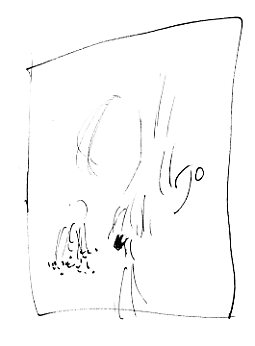One of my all time favorite Peanuts panels is from the late 70s. Sally has corralled Snoopy first into helping her scare away bullies at the playground (“Speak softly and carry a beagle,”) and then into terrorizing innocents at the playground (“Speak loudly and carry a beagle.”) In this strip, Sally is stomping off to force some kid out of the sandbox. She thinks Snoopy is right behind her, ready to bark ferociously and run the kid off. But Snoopy, unbeknownst to Sally, suddenly perks up his ears and stares off frame. “My old flame!” he declares, and disappears. Sally’s left to the tender mercies of her unterrorized peers (“How can you speak softly and cary a beagle without a beagle!”) As for Snoopy and his flame…your guess is as good as mine. Was Snoopy just wandering off into one of his own fantasy scenarios? Did he really see a girl beagle from his youth? It’s a mystery. Schulz never followed up on the storyline. Snoopy disappeared from the panel, from the strip, and from the story.
Or at least, I think that’s what happened. My copy of that Peanuts volume has disappeared, like Snoopy, into white space. It’s probably somewhere or other, but where exactly I have no idea. Unless, as is possible, I confused the date, and it’s in another volume?
In any case, I think that panel (whether it exists or not) out of which Snoopy disappears perfectly captures much of what I love about Schulz. He’s a cartoonist of mental cliffs; especially by the late 70s or 80s, his stories often don’t quite fit together, or stagger to the end of one panel and then fall off precipitously into nothing. The bizarre transitions, the repetitions, the way Snoopy’s fantasies often blend into reality; the strip seems more badly remembered than written, all loose ends flapping about leisurely in the forebrain.
Snoopy’s sudden memory come to maybe life somewhere out there in the gutter we never see is a perfect example of the way Schulz narratives are eaten by their own aphasia. Sally knows what comes next in the tyrannical sequence, but suddenly the seqart forgets the seq. Where Snoopy goes following this panel is nowhere; he drops out. Which, in some sense, means the only thing around this panel is blank space. The fact that I don’t remember the panels before or after only emphasizes the point; those panels don’t exist.
I just got Stanley Cavell’s book titled something or other, in which he’s supposed to talk about the importance of memory in the appreciation of film. One could argue that memory is less important in comics, I suppose — but I wonder. Even the comics we love most spend more time in our memories than they do in front of our eyes. Characters push themselves up and off and move across the gutters; words speak; some panels disappear; others, like Snoopy himself, come unmoored. Art most of the time isn’t the beautiful thing in front of you, but rather the lonely synapse failing to fire while you realize with a sinking feeling that you’ve lost your beagle.
Sally doesn’t like that sensation at all, of course, but she’s a literal sort. You have to think Snoopy, or at least Schulz, rather enjoys the way panels and brains open up and drop you from one to the other, like a pratfall in a dream.
________________
This was inspired by the series of one-panel posts by our neighbors at The Panelists.


I enjoyed reading this–nice observations about Schulz and panels…and Snoopy.
Thanks!
There’s a strange pleasure in art that tips over into dissolution, into the void…
It’s the pleasure I got from Clint Eastwood’s film ‘Pale Rider’, or from Mark Twain’s ‘The Mysterious Stranger'(at least, the version I know)…not far removed from the pleasure of the incomplete, such as in Charles Dickens’s ‘The Mystery of Edwin Drood’ or in F. Scott Fitzgerald’s ‘The Last Tycoon’.
Where does this come from?
Alex, it seems like it’s related to mystery in part. It can be evocative…I don’t know. There’s a satisfaction to things clicking together, and a satisfaction to things with the bits not connecting…. I think there’s certainly a pleasure to being asked to imagine or complete a work yourself. You end up feeling like you’re working with the artist, or being allowed to fill some parts in.
Pale Rider is such a great movie.